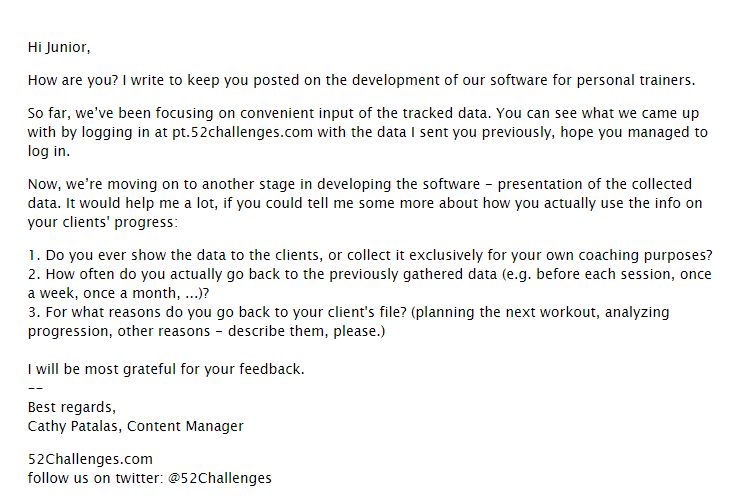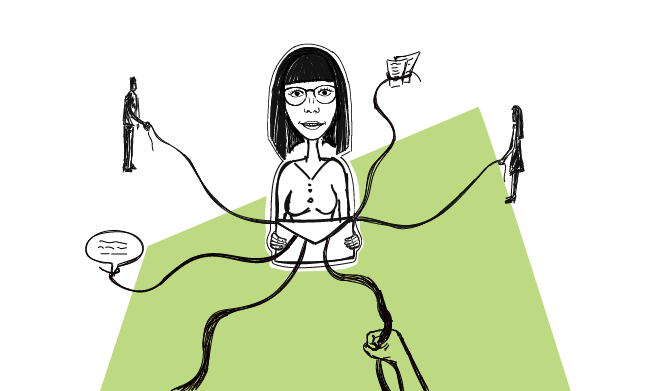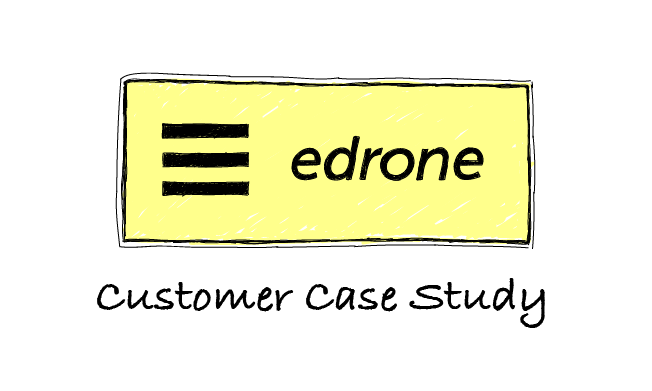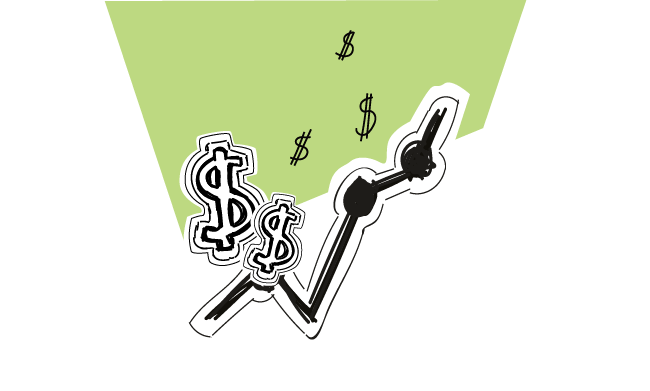This is the final part of this article. I’m describing here the third email of the interview we carried out at 52Challenges that helped us learn a lot about our prospects’ job specifics and define the most crucial features in our SaaS.
Read on if you want to see a real-life example of how email interviews can help to build a SaaS business.
To check out the previous part of the story (along with email templates), please see:
- Part 1 of this article – where I describe why customer interviews can be a powerful tool to help you build a SaaS company, why we decided to perform customer interviews via email and how we got around that in the first place.
- Part 2 of this article – where I describe how and why we continued the interview – and how you could benefit from doing so as well.
***
What we already had at this point
Let’s start with a little reminder.
What we had after the first two parts of the interview was:
– a crucial pain point of our prospects’ group that we wanted our SaaS to solve;
– information on what the prospects currently used to somehow cope with that pain plus a more detailed info on what kind of data they usually work with.
After two such rounds you should already have some important info, too. Ideally, in your case it’s also your prospects’ pain points and the solutions they use right now to deal with them. This way you’ll be able to decide whether your business idea makes sense or perhaps you should adjust it.
What should the final part of the interview be about?
The third part of the interview can, hopefully, help you to decide on the further direction of development.
That’s what it did in our case. We found out the trainers collect various kinds of information about their clients’ progress. Now we wanted to find out how they use the information later on.

As you can see, the first three paragraphs make a kind of re-introduction to the topic. The third interview email was sent after some time, so I wanted to make sure the trainers are back in the context – remember who I am, what I do, what I want from them and why. I write a bit more about the importance of such introductions in email sequences in the Part 2.
The only thing I would now change about this email, would be to make it shorter. The email worked because we had created a basic connection with the trainers. So, in this sense, this email right here is not exactly a cold one.
Even though it wasn’t an initial outreach (which always has to be short) , if I was to write the email again today, I would make it shorter.
How to construct the questions
As I’ve mentioned in the first part of this post, there are three simple rules for asking questions in such an interview:
- keep the questions simple
- ask open-ended questions
- ask about the prospects’ reality, not your solution
The questions we asked, again, were about how the trainers work. And again, I tried to make them as easy to answer as possible.
The first one is an either-or type of question. Yes, I know it’s not an open-ended question, but I like this type because it seems very easy and does not involve much effort to answer – at least at first sight. They have just two options to choose from, which should make the choice easy.
In fact, such a question is usually a perfect trigger to elicit a longer response. Because in life, there are hardly ever pure either-or situations. Much more often it’s “usually, I do this, but sometimes I do that… it depends on… etc.” – that’s the kind of answers I’m always more than happy to get in an interview. And that’s what I actually got very often in response to this one.
The second one is about the frequency of getting back to the collected data. It’s an open questions that involves some triggers for the interviewee to resonate with.
The third question is very similar in its construction to the second one. (You’ll find more about open questions like the second and the third one in Part 2).
What can you gain from this part of the interview?
This part of the interview may help you plan your further development. Basing your questions on what you’ve already learned about your prospects, confront the ideas you have for your next features with them.
That’s what we did with those three simple questions.
Thanks to the second part of the interview, we established that many trainers collect their clients’ progress data using paper files or Excel.
We needed to define another additional value 52Challenges could offer them. We decided to combine the ease of collecting progress notes with the powerful presentation of results. The idea sounded valid to us, but we wanted to confront it against the realities of personal trainers’ job. And we successfully managed to do that thanks to this part of the interview.
What we gained from the three-part interview as a whole
We established a closer connection with our group of prospects. As a result, we weren’t strangers to our testers and first users. They knew us and they knew how we built the software, so they were more eager to try out our solution.
We gained priceless knowledge of our group of prospects. We learned how they work, how they speak, what they focus on working with their clients. We learned what is important and relevant to them. That helped us build better copy for our upcoming emails, and our landing page.
We gained experts’ opinions. We were able to talk to the people whose daily problems we wanted to solve. They told us what they struggle with and what they would need to stop struggling so much. They later helped us improve our SaaS to more properly match their needs.
What’s in it for you?
Realise the WHY
I know it’s difficult and I know you would rather focus on developing the great app or service you’ve got on your mind. Nonetheless, in the long run, it’s more beneficial to both you and your customers if you interview before you develop. If you don’t want to take my word for that, take Jason Lemkin’s.
Your potential customers are the best experts to consult. They won’t tell you how to build a solution for their problems. But when skillfully asked, they will tell you what they really struggle with. And that’s the first step you need to take. In order to solve a problem, you need to understand it first. Otherwise, you risk building something that you will love, but nobody will want to use. And that’s painful indeed.
Take really good care of the HOW
Make the interview parts digestible. Note that none of our three messages involved more than 3 questions. If you want your interviewees to answer, you need to make the process of answering easy and not very time-consuming. Well-crafted, short and easy questions can elicit most valuable answers. Prepare the right questions and find the best possible channel to ask them. Yes, it takes a lot of time. But it definitely pays off in the end.
Make sure your prospects know what they can gain if they help you. This is what motivates them to keep sending answers to your emails. If they feel your solution will actually alleviate their pain, they will be more eager to share their knowledge and experience. If you make them see the real gains in time and money, they will help you even more eagerly.
Final words
That’s what worked for us. It doesn’t mean the same will work for you. That’s the hardest part, I think. But I strongly encourage you to do so: the benefits you may reap will be well worth the time and energy you invest in it.
Find a way for the interviews that will work for you and your prospects. So do your research, check what’s working best and keep interviewing until you see a pattern, until you know the pain, until you discover the best direction for your solution.
And when you do that, please feel more than welcome to share your experiences with us here. We are genuinely interested in what works for you and your SaaS business.
READ ALSO

What Can You Use Cold Emails for in a SaaS Company, besides Outbound Lead Generation?
What’s the first thing that comes to our mind when we think of cold emails in a start-up? Prospecting. Lead generation. Finding new customers potentially interested in our product or service. Fair enough. That’s probably the core application of B2B cold emails right now. But we can do more than that. So, what else can you use cold emails for in your SaaS company?

10 Factors that Make Our Cold Emails Work (or Not)
If you're sending cold emails, you know that sometimes your messages work amazingly well, sometimes they work OK, and sometimes they don't work at all. And whether your outreach works great, or it hardly works at all, there's always a reason for that. Actually, in most cases, there's a whole collection of reasons for that. Here's a list of 10 factors that you may want to check to discover the cause of your campaign's success or failure, and to improve the effectiveness of your emails in general.

Customer Case Study: How edrone.me Builds Relations with Future Customers Using Cold Email
It's a dream for a SaaS team when they hear that a customer of theirs is satisfied with the service and wants to share their experience as a case study. That's what happened to us when Michal Blak, the Co-founder and CEO of edrone.me told us that he's open to tell the story of his team's experiences with Woodpecker. Michal Konieczny, who takes care of business development at edrone, added his two cents and here we are. Check how the e-commerce CRM uses Woodpecker to start conversations with their ideal customers.

